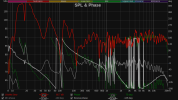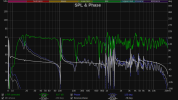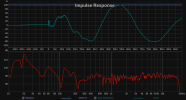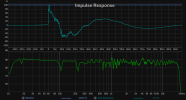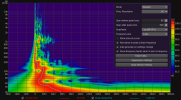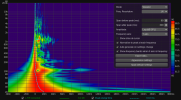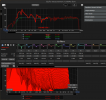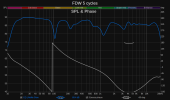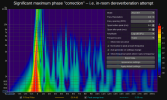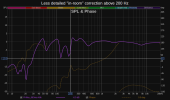AudioBoy
Member
- Joined
- Jan 23, 2023
- Messages
- 66
- Likes
- 34
Hello guys!
I was wondering is it possible to correct the phase using REW mathematics? What prevent us to use this app potential to get rid of excessive phase elements in our measurements and get nearly perfect FIR filter which then could be used in Roon or Equalizer APO?
Of course there is great app by the name of rePhase and bla-bla-bla... But its developer no longer interested in add more features in it as I think.
Also fixing the phase manually its kind a hard if you has a very complex phase shape graph or don't know your XO frequencies.
I think I got some sort of acceptable results but could not export usable FIR filter. Maybe you could provide some help so I can finish it.
Let's take some measurements of accoustics in some abstract living room.

Then make some equalization of frequency response or completely ignore this step if you don't need it. But if you do you'll get a set of eq filters to work with later.

The step response looks like this and far from perfect.

Next let's create minimum phase version and excess phase version of our equalized FR graph using REW.
The step response of minimum phase version graph and phase itself looks great!
I want it too

If I understand documentation correctly our measured phase of frequency response consists of minimum phase + excess phase. So if we could get rig of excess phase from our measured phase we can get a minimum phase version. Then we could build a FIR filter which corrects frequency response and phase altogher.

To do this we need to invert excess phase to create first multiplier for futher work. Let's generate it.

I called the result as Inverted Excess.
Then multiply equalized frequency response measurement (L EQed in my case) to inverted excess graph.
As result we got equalized FR graph without excess phase that is minimum phase version of it.

Phase now looks great (for minimum phase )!
)!

But step response (and impulse response) got some pre-ring junk (rounding errors I guess) and its no good.

To get rid of them frist we need to extract those errors and then exclude them from our graph (Shaggy EQed MP as I called it).

The errors graphs (let's call it Junk) should look something like this

OK. now we can exclude errors from our Inverted Excess Filter and create Min Phase Filter

Test it by multipling L EQed graph to Min Phase Filter.

Everything looks wow! I believe you could never achieve similar results using rePhrase.
Believe me I tried a lot
But here comes the hardest part - how to export created FIR filter without losing it precision?
First of all, it's huge!
But I guess there are a lot of junk information which could be trimmed.

Second,
when multiplied by an EQ filter, it can introduce errors into the final filter, resulting in strange pre-ringing. This is noticeable in the step response graphs (maybe I could excluded it the same way as I did previously). Although if you multiply everything one by one, then everything looks good, as in the pictures I provided. When listening using such a filter, some kind of high-frequency whistle or sound appears in the music, although everything else seems to be in order.
In general, I'm stuck here and would be glad for any ideas and help.
Thanks in advance.
I was wondering is it possible to correct the phase using REW mathematics? What prevent us to use this app potential to get rid of excessive phase elements in our measurements and get nearly perfect FIR filter which then could be used in Roon or Equalizer APO?
Of course there is great app by the name of rePhase and bla-bla-bla... But its developer no longer interested in add more features in it as I think.
Also fixing the phase manually its kind a hard if you has a very complex phase shape graph or don't know your XO frequencies.
I think I got some sort of acceptable results but could not export usable FIR filter. Maybe you could provide some help so I can finish it.
Let's take some measurements of accoustics in some abstract living room.
Then make some equalization of frequency response or completely ignore this step if you don't need it. But if you do you'll get a set of eq filters to work with later.
The step response looks like this and far from perfect.
Next let's create minimum phase version and excess phase version of our equalized FR graph using REW.
The step response of minimum phase version graph and phase itself looks great!
I want it too
If I understand documentation correctly our measured phase of frequency response consists of minimum phase + excess phase. So if we could get rig of excess phase from our measured phase we can get a minimum phase version. Then we could build a FIR filter which corrects frequency response and phase altogher.
To do this we need to invert excess phase to create first multiplier for futher work. Let's generate it.
I called the result as Inverted Excess.
Then multiply equalized frequency response measurement (L EQed in my case) to inverted excess graph.
As result we got equalized FR graph without excess phase that is minimum phase version of it.
Phase now looks great (for minimum phase
But step response (and impulse response) got some pre-ring junk (rounding errors I guess) and its no good.
To get rid of them frist we need to extract those errors and then exclude them from our graph (Shaggy EQed MP as I called it).
The errors graphs (let's call it Junk) should look something like this
OK. now we can exclude errors from our Inverted Excess Filter and create Min Phase Filter
Test it by multipling L EQed graph to Min Phase Filter.
Everything looks wow! I believe you could never achieve similar results using rePhrase.
Believe me I tried a lot
But here comes the hardest part - how to export created FIR filter without losing it precision?
First of all, it's huge!
But I guess there are a lot of junk information which could be trimmed.
Second,
when multiplied by an EQ filter, it can introduce errors into the final filter, resulting in strange pre-ringing. This is noticeable in the step response graphs (maybe I could excluded it the same way as I did previously). Although if you multiply everything one by one, then everything looks good, as in the pictures I provided. When listening using such a filter, some kind of high-frequency whistle or sound appears in the music, although everything else seems to be in order.
In general, I'm stuck here and would be glad for any ideas and help.
Thanks in advance.


